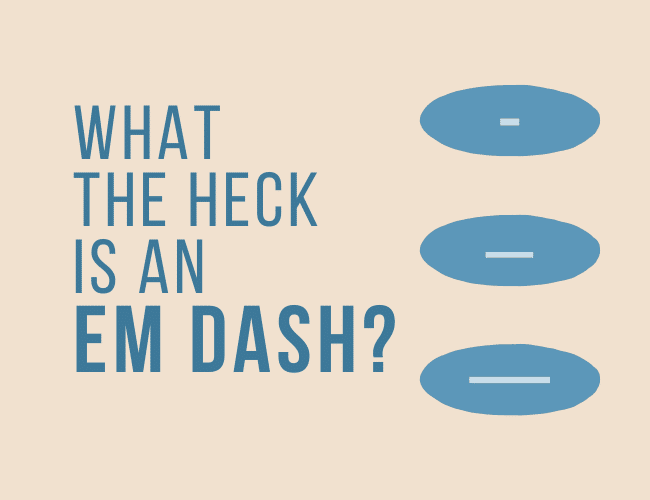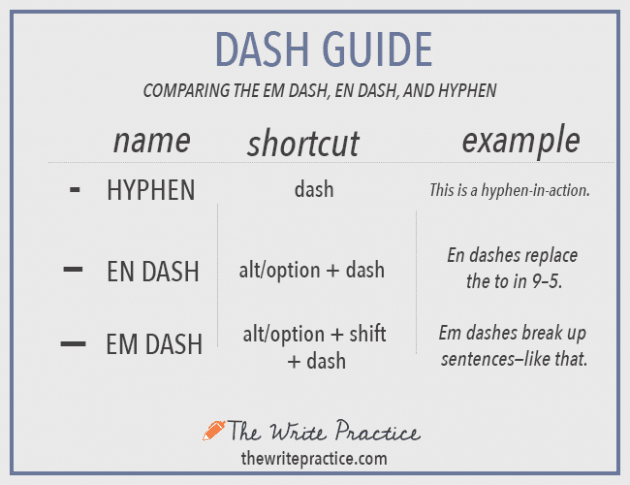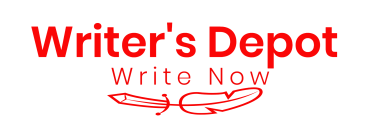The article Em Dash Shortcut: What the Heck Is an Em Dash and How Do You Use It Correctly? appeared first on The Write Practice.
You’re writing an email, essay, or even—hey why not?—a book, and as you write, you think, “I need one of those long dash, double hyphen things. What are those things called, again? And how do I make sure I use it correctly so I don’t look like an idiot?” Let’s look at what an em dash is and how to use one correctly.

If that’s you, don’t fret! You have this whole guide to learn more about what an em dash is, when to use it, how it’s different than other kinds of dashes and hyphens, and how it can add style (if it’s not overused) to your writing.
But maybe you’re thinking, “I’m actually just here to copy paste an em dash. I don’t want to learn anything, thank you.”
No problem!
Copy and Paste an Em Dash Here
Copy and paste this:
—
There you go. That wasn’t so hard, right?
And if you want to learn how to create them for yourself—or go above and beyond and learn to use them correctly—then read on!
Em Dash Keyboard Shortcuts: How Do You Make an Em Dash?
Warning: To correctly make an em dash on Word and other word processors, DO NOT use two consecutive hyphens or a double dash.
Two adjacent hyphens (that’s two of these, no spaces between them: – -) combine to form an en dash, like this one: –. An en dash looks similar to an em dash, but they’re used in totally different situations (more on that below).
Plus, on other web editors, like WordPress, Twitter, and Facebook for example, those two hyphens don’t magically become dashes of any variety. They stay two hyphens forever with that pesky little gap between them. Don’t do it!
This bears repeating: when you put two hyphens together, you do not create an em dash.
So how do you create an em dash? You have three options:
1. Copy and Paste
Want that copy-and-paste em dash again? Here you go:
—
But you likely don’t want to search “em dash copy and paste” every time you need an em dash. So here’s how to create one yourself:
2. Best Option: Use the Em Dash Keyboard Shortcut
There is a simple shortcut that includes the dash key on your keyboard that will quickly and easily create an em dash.
Em Dash Shortcuts for PC and Mac
PC: alt/option + shift + hyphen (-)
MAC: option + shift + hyphen (-)
3. Second Best Option: Use the Symbols Section on Word or WordPress
If you’re in a program that includes a formatting toolbar, like Microsoft Word, you can use the symbols or special characters section of your word processor and search for the em dash there.
But why hunt and peck when you can use a quick and easy keyboard shortcut? Master the keyboard shortcut, and you can make your very own em dash anytime you need one.
But beware, because with great power comes great responsibility. Now that you can make an em dash, how do you know if you’re using it correctly?
Em Dash Definition: What Is an Em Dash?
An em dash is a versatile punctuation mark that looks like an extended dash. It is used to break up a longer sentence, usually to insert a phrase into the middle or end of a sentence, to add modification phrases to a list, and sometimes to show a break in narration or conversation.
Em dashes are also known as an m dash, m-rule, long dash, or, in grammatical slang circles, “mutton.” The New York Times even called it “the bad boy or cool girl” of punctuation and a freewheeling scofflaw. So there you go!
Em Dash Examples
You’ve probably seen a lot of em dashes, maybe without ever noticing. Here’s what they look like in a sentence:
Andy scanned the budgets on his desk, noting that Margot’s handwriting—and most of her work, in fact—was less than satisfactory.
Or, in dialogue:
“Carl, I honestly don’t know why you—”
“Stop, Lauren! I will put hot sauce on my pasta instead of marinara if I want to.”
Now that you know what to look for, you might start seeing them everywhere. But when do you use an em dash? What’s the benefit of it, and why do writers sometimes misuse this wonderful piece of punctuation?
When Should You Use Em Dashes? 6 Places to Use an Em Dash
Em dashes are versatile. They have uses both in formal and informal writing. They can take the place of commas, parentheses, colons, ellipses, semicolons, and even—for some writers—quotation marks.
Here are the situations you might use an em dash:
1. To insert a phrase into the middle of a sentence as a stronger comma.
Em dashes might be used instead of a comma if there are a lot of commas already used in a sentence or paragraph and you want to switch it up, or for a stylistic choice.
Here’s an example from The Write Structure:
If you’ve ever told a good story—one that has your friends or family on the floor laughing, or else on the edge of their seat asking, “What happened next?!”—then you know that you can’t get to the point of the story too quickly.
Notice how the em dashes separate a phrase with a lot of other punctuation. A comma alone wouldn’t work, because it wouldn’t be strong enough against the other pieces of punctuation.
Em dash to the rescue!
2. To add an aside in place of or in addition to parentheses.
In more formal writing, you can use em dashes in place of parentheses when you’re making an aside comment or parenthetical statement.
Here’s an example, again from The Write Structure:
While you may choose more than one value—perhaps a value for a subplot or the internal genre—if you try to move your story on too many values it will become muddied and will be very hard to work with in your second draft.
Maybe you’re even already using a parenthetical statement, and you need to add another aside to your aside (like this—see?). Make your parenthetical statements work harder with an em dash!
3. To modify a list or a single item in a list.
When you have a list broken up by commas, and you want to add detail about one item in that list or even the list itself, a comma alone isn’t strong enough. In some situations, you could instead use semicolons in place of your list-separating commas, but em dashes are a good alternative as well.
Here’s how it looks, using an example from The Write Structure:
That means the average novel, film, or screenplay—which have fifty to seventy scenes—should have fifty to seventy rising actions and fifty to seventy climactic choices.
See how the em dash, in this case, adds more information about the whole list? Em dashes can be useful any time you’re trying to insert more information into a list.
4. To begin a list instead of a colon.
Writers might use a colon at the end of a sentence to transition to a list. An em dash can do this too if the colon is used to separate extra information at the end of a sentence.
I’ve been waiting ten years to go on my favorite vacation: a trip to New Zealand!
With an em dash instead of a colon, the sentence becomes:
I’ve been waiting ten years to go on my favorite vacation—a trip to New Zealand!
In most situations, a colon is better than an em dash, but if the list is being tacked on to the end of a complete sentence, or feels like an aside (see above), then an em dash might make sense.
5. To show a break in narration or conversation in place of an ellipsis.
Em dashes can replace ellipses to show an abrupt break in a conversation. Where an ellipsis might instead feel more like a trailing off, an em dash can feel like a sudden break.
As with our previous example:
“Carl, I honestly don’t know why you—”
“Stop, Lauren! I will put hot sauce on my pasta instead of marinara if I want to.”
You might instead use an ellipsis here, but the em dash is a stylistic choice that makes it feel more abrupt.
6. In a quotation before the author’s name.
When you’re formatting a quote, perhaps for the epigraph of a book, an em dash comes before the author’s name, like this:
Em dashes are the best punctuation mark!
—Joe Bunting
7. Not recommended: In place of a quotation mark.
Some writers, like James Joyce, used em dashes in place of quotation marks, what is sometimes called a “quotation dash.”
Here’s a section from Joyce’s novel Ulysses:
The fellows talked together in little groups. One fellow said:
—They were caught near the Hill of Lyons.
—Who caught them?
—Mr Gleeson and the minister. They were on a car. The same fellow added:
—A fellow in the higher line told me.
Very few writers do this, today, and all major style guides use regular quotation marks instead of em dashes for dialogue.
You’re now armed with six ways to use em dashes (and a seventh, if you’re feeling bold). But when should you avoid using an em dash?
When to Avoid Em Dashes
Em dashes are wonderful little pieces of punctuation, but like any special treat, you can have too much of a good thing.
Too many em dashes can break up the flow of your writing, causing it to read like a third-year philosophy doctorate student’s term paper (unless you’re doing academic writing, this is not something you want—trust me).
As my editor has often told me, more than two em dashes per page is a cry for help.
To see examples of poorly used em dashes, look no further than the Twilight series, about which Dana the blogger has compiled a bunch of examples of poorly placed em dashes. As with dessert, wine, and Nikki Minaj concerts, moderation is the key.
Should You Use a Space Before and After an Em Dash?
You might see some em dashes formatted—like this—with no spaces.
And then, in a book or the newspaper, you might see them differently — like this — with one space around each em dash.
Which is correct?
The answer is: it depends. And if that’s confusing, welcome to the world of competing style guides.
Here’s the thing: there are different “correct” ways to format punctuation depending on whom you’re writing for. Most style guides, like the Chicago Manual of Style and APA style, say you should not use spaces between em dashes.
However, there’s one major style guide that says em dashes should have spaces, and that’s AP style. Since AP style is also the style guide that most newspapers use, you may see a lot of em dashes with spaces.
The question is, which method should YOU use?
Answer: Unless you’re writing for a newspaper, no spaces before and after your em dashes is the best bet.
Now you’re handy with the em dash, ready to place it in all the appropriate places, surrounded by no inappropriate spaces. But beware—if you’re looking for the em dash, your keyboard has a few false friends to distract you. Let’s look at how not to confuse your em dashes with en dashes, hyphens, or minus signs.
The Full Dash Guide: Em Dash vs. En Dash vs. Hyphen vs. Minus Sign
There are actually three different types of dashes, and it’s very easy to mix them up.
Not sure the difference between the three? Here’s a cheat sheet for the different types of dashes:

As you can see, the em dash is the longest of the three, and roughly the width of the letter m, which is how it got its name.
(And yes, the en dash is named because it’s the width of the letter n.)
The em dash also acts as the longest stop or pause in a sentence compared to the other three dashes, which all serve to join parts of sentences rather than break up a sentence and stop the reader.
Let’s talk about the differences.
Hyphen
A hyphen connects two elements that are joined together to function as one word.
Here are some examples of hyphenated words: best-seller, two-year-old, pre-Hanukkah, and anti-racist.
An em dash cannot be used as a hyphen (and a hyphen, likewise, cannot be used as a hyphen).
The rules for hyphenating words are extensive, but here’s a quick reference list to get you started:
- Compound adjective + noun (a best-selling book)
- Terms for age if they’re in front of the noun (a nine-year-old child, but not a child who is nine years old)
- Some numbers (twenty-one through ninety-nine)
- Some prefixes (though not all)
- Confusing combinations of words where a hyphen will help with clarity
Not sure when to use a hyphen? Check out the Chicago Manual of Style Hyphenation Table for a quick-reference guide to all your hyphenation needs. And if you’re still not sure, look up a word in a dictionary like Merriam-Webster to see whether they hyphenate the term.
Double Hyphen
A double hyphen is a punctuation mark that uses two parallel hyphens, like this: ⸗. It looks more like an angled equal sign (and is even called an angled dash by some).
This is most often used with typefaces, or used for commercial purposes that give the punctuation mark some visual effect, like this:
Malbaum⸗Franktur
Let’s be honest, though: you probably won’t see much of this type of hyphen. It’s had some historical use and some uses in other languages, but if you’re writing in English, you’re almost certainly better served with another hyphen or dash option.
En Dash
The en dash is used to indicate a range. You can use it in many places where you might otherwise say “to” or “through.”
For instance, this range of dates:
I am going on vacation from July 4 through July 8.
. . . becomes a shortened, punctuated range:
I am going on vacation from July 4–8.
Em dashes don’t indicate ranges of numbers or words, and they don’t act as a substitute for “through.”
Minus Sign
A minus sign and a hyphen are the same length: a short, single line (-). From a typing standpoint, they’re interchangeable. You’ll use the same key to make a hyphen or a minus sign, whether you’re connecting two words or writing a mathematical equation.
The em dash is longer, and it doesn’t have a mathematical usage. For instance, don’t write this:
A–B=C
Instead, use that minus sign:
A-B=C
Bonus! More Punctuation Resources
Do you feel confident about when to use an em dashes now but still have budding grammar questions? Some of these additional resources on The Write Practice blog might be exactly what you’ve been looking for:
Create Your Own Words (and Other Uses Of the Hyphen)
What’s an En Dash? (And How to Use it Correctly)
How to Use an Ellipsis … Correctly
Need more grammar help? My favorite tool that helps find grammar problems and even generates reports to help improve my writing is ProWritingAid . Works with Word, Scrivener, Google Docs, and web browsers. Also, be sure to use my coupon code to get 20 percent off:
PRACTICE
Write for fifteen minutes on the following writing prompt . Use em dashes to provide insight into the mind of the characters, or to show interruptions in dialogue.
Prompt: Ashley stared at Max, who was sitting in the middle of the disheveled living room.
When your time is up, post your practice in the Pro Practice Workshop here. Then, be sure to give feedback to your fellow writers by commenting on whether they used the em dash correctly.
The article Em Dash Shortcut: What the Heck Is an Em Dash and How Do You Use It Correctly? appeared first on The Write Practice. The Write Practice – Transforming Aspiring Writers into Published Authors
Go to Source
Author: Liz Bureman
